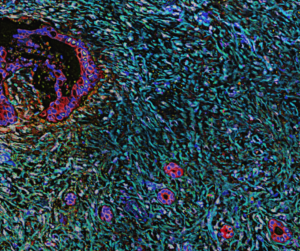Lucia Diaz, DNP, ANP-BC, CUNP
It is estimated that between 19% and 100% of patients receiving antineoplastic medications known to cause neuropathy may develop chemotherapy-induced peripheral neuropathy (CIPN)1, which may be irreversible.2 This complication is not limited to motor/sensory deficits of the extremities; it can affect the urogenital tract and negatively impact the quality of life (QoL) of those affected.3 More than 70% of patients receiving neurotoxic antineoplastic medications have reported lower urinary tract symptoms (LUTS).3 The effect of neurotoxic chemotherapy agents on the autonomic nervous system often leads to unrecognized urogenital dysfunction where voiding or erectile dysfunction result.2,3 Like CIPN, the severity or chronicity of LUTS may increase with age, male sex, tobacco use, diabetes, renal impairment, or pre-existing neurological disorders.1-4
Voiding dysfunction symptoms can be divided into three LUTS groups:
- Storage symptoms (frequent urination, urgency of micturition, nocturia, and urine incontinence)
- Voiding symptoms (weak stream, hesitancy, intermittency, straining to void, and terminal dribbling)
- Post-void symptoms (post-void dribbling and feeling of incomplete bladder emptying)5
The impact on QoL and associated expenditures related to disruptive urinary symptoms are significant.3,5 Therefore, proactively educating patients at the start of treatment on the potential signs and symptoms of voiding dysfunction related to CIPN may help prevent poor voiding dysfunction outcomes, as it allows for early reporting, assessment, and management of LUTS.
Clinicians may consider complementing clinical assessment of LUTS with validated tools (see Table).
| Table. Validated Tools for Clinical Assessment of LUTS6 |
| International Prostate Symptom Score (IPSS) |
| International Consultation on Incontinence Questionnaire—Overactive Bladder Module (ICIQ-OAB) |
| The International Consultation on Incontinence Questionnaire—Urinary Incontinence (ICIQ-UI) |
It may be beneficial to provide questionnaires prior to starting chemotherapy to obtain a baseline symptom score and for patients to become familiar with potential LUTS they should report. Should symptoms be present and bothersome, or if there is concern for urine retention, a urology referral may be indicated.
Advanced practice providers (APPs) play a crucial role in patient education, assessment, and management of adverse effects caused by neurotoxic chemotherapeutics. APPs are therefore strongly encouraged to assess a patient’s micturition status prior to starting any chemotherapy treatment and reassessing periodically, particularly if CIPN symptoms are present.3 Optimizing the treatment of co-morbid conditions, such as diabetes, may lessen the severity of CIPN-related LUTs or help prevent it in those that are predisposed to development of CIPN.7 Early assessment and intervention of CIPN and LUTS may not only improve cancer treatment outcomes but may also positively impact a patient’s QoL during and after cancer treatment.2

References:
- Zajączkowska, R., Kocot-Kępska, M., Leppert, W., Wrzosek, A., Mika, J., & Wordliczek, J. (2019). Mechanisms of Chemotherapy-Induced Peripheral Neuropathy. International journal of molecular sciences, 20(6), 1451.
- Kanzawa-Lee G. A. (2020). Chemotherapy-Induced Peripheral Neuropathy: Nursing Implications. Journal of infusion nursing : the official publication of the Infusion Nurses Society, 43(3), 155–166.
- Cho, O. H., Yoo, Y. S., Kim, J. C., Park, R. H., & Hwang, K. H. (2018). Factors Influencing Lower Urinary Tract Symptoms in Advanced Cancer Patients With Chemotherapy-Induced Peripheral Neuropathy. International neurourology journal, 22(3), 192–199.
- Calogero, A. E., Burgio, G., Condorelli, R. A., Cannarella, R., & La Vignera, S. (2019). Epidemiology and risk factors of lower urinary tract symptoms/benign prostatic hyperplasia and erectile dysfunction. The aging male : the official journal of the International Society for the Study of the Aging Male, 22(1), 12–19.
- Agarwal, A., Eryuzlu, L. N., Cartwright, R., Thorlund, K., Tammela, T. L., Guyatt, G. H., Auvinen, A., & Tikkinen, K. A. (2014). What is the most bothersome lower urinary tract symptom? Individual- and population-level perspectives for both men and women. European urology, 65(6), 1211–1217.
- Faithfull, S., Lemanska, A., Aslet, P., Bhatt, N., Coe, J., Drudge-Coates, L., Feneley, M., Glynn-Jones, R., Kirby, M., Langley, S., McNicholas, T., Newman, J., Smith, C. C., Sahai, A., Trueman, E., & Payne, H. (2015). Integrative review on the non-invasive management of lower urinary tract symptoms in men following treatments for pelvic malignancies. International journal of clinical practice, 69(10), 1184–1208.
- Mezzanotte, J. N., Grimm, M., Shinde, N. V., Nolan, T., Worthen-Chaudhari, L., Williams, N. O., & Lustberg, M. B. (2022). Updates in the Treatment of Chemotherapy-Induced Peripheral Neuropathy. Current treatment options in oncology, 23(1), 29–42.







